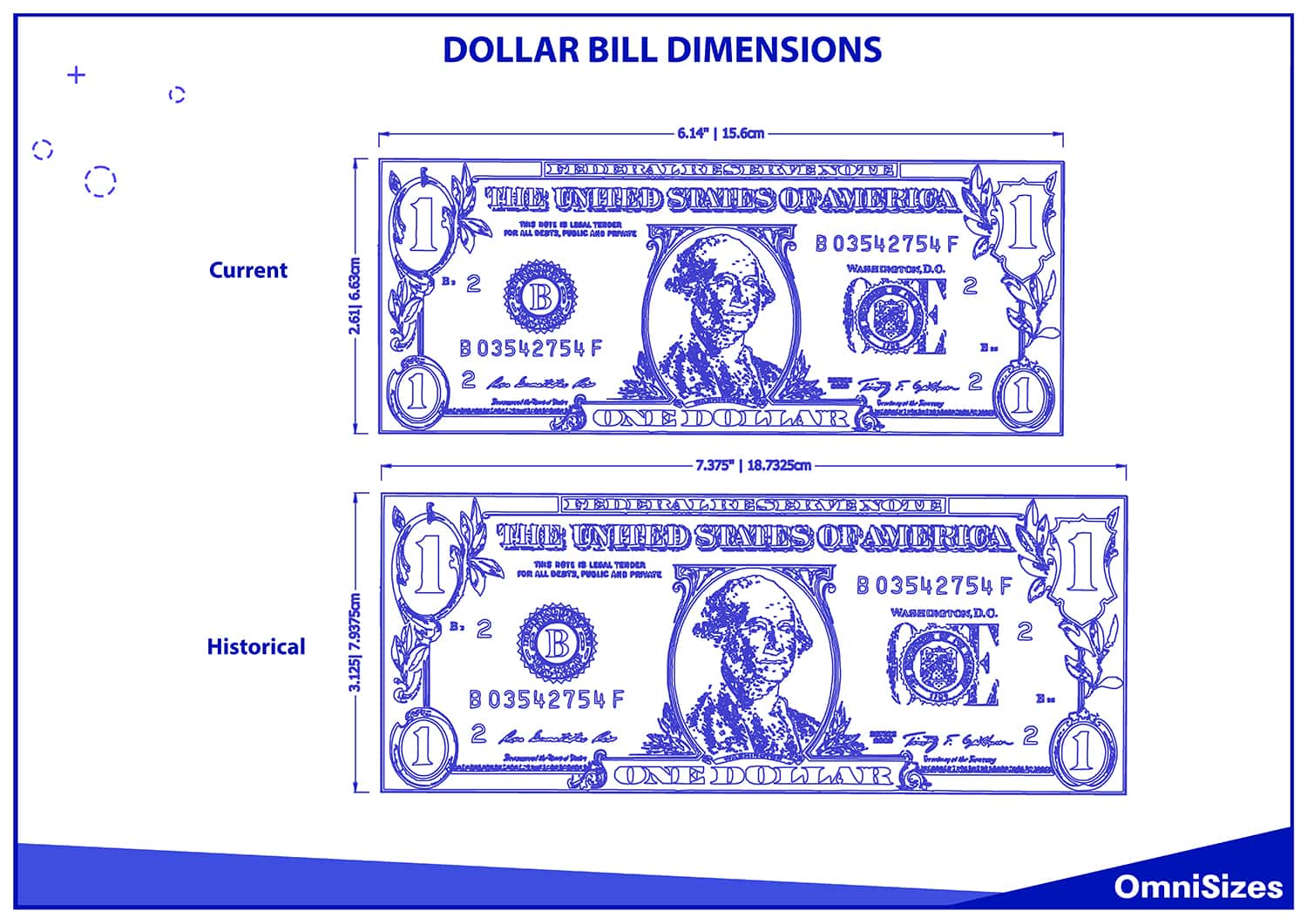Dollar bills are a familiar part of daily life and are used in countless transactions across the United States. One way to notice a fake is to look at the dollar bill dimensions. So, how big are they?
The current dimensions of the US dollar bill are 6.14 × 2.61 inches (15.6 × 6.63 cm). Historically, dollar bills were larger; the series issued before 1929 measured approximately 7.375 × 3.125 inches (18.7325 × 7.9375 cm).

This guide will briefly cover the history of the dollar bill, as well as explore the dollar bill’s size, material, and printing process in more detail.
History of the Dollar Bill
The history of the dollar bill in the United States dates back to the late 18th century. Following the Revolutionary War, the newly formed United States needed a standardized currency to unify the economy.
The Coinage Act of 1792 established the dollar as the country’s standard unit of money. However, these early dollars were in coin form. Paper money, then called ‘Continental Currency,’ was also in circulation but was subject to counterfeiting and rapid devaluation.
The move towards a paper-based currency system gained momentum in the 19th century. The introduction of Demand Notes in 1861 marked the first issuance of paper money that was recognized as legal tender by the United States government. These notes were a response to the financial exigencies of the Civil War.
Subsequently, in 1862, the United States began issuing United States Notes, also known as Legal Tender Notes, which further established paper currency’s place in the American economy.
The design of the dollar bill has been a continuous evolution. The early notes were relatively simple in design and lacked sophisticated anti-counterfeiting measures. However, as counterfeiting became more prevalent, the government responded by enhancing the security features. This included intricate designs, watermarks, and special inks. The Bureau of Engraving and Printing (BEP) had a direct role in these developments.
The dollar bill continues to evolve. The most recent redesigns focused heavily on enhancing security features to combat advanced counterfeiting techniques. These include color-shifting ink, watermarks, and security threads. The design also incorporates symbols of American history and values.
Dimensions of Dollar Bills
If you want to learn more about dollar bill dimensions, you should know its measurements in current and past standards.
Current Dollar Bill Dimensions
The current standard size of a United States dollar bill is 6.14 inches long and 2.61 inches wide, or 15.6 centimeters by 6.63 centimeters. This uniform size applies to all denominations of US paper currency. The standardized dimensions, established in 1929, aimed to create a more efficient and manageable currency system. The thickness of a single dollar bill is approximately 0.0043 inches, or 0.11 millimeters.
Historical Dollar Bill Dimensions
US dollar bills were larger and varied in size. The first federal paper money issued in 1861, known as Demand Notes, had dimensions of around 7.375 inches by 3.125 inches (18.7325 × 7.9375 cm). These larger bills were common until the early 20th century.
The shift to smaller dimensions in 1929 was part of a broader initiative to standardize and streamline US currency. This move was driven by practical considerations, such as ease of handling, storage, and the desire for a more modern and efficient currency system.
Material and Durability
Apart from its size, there’s so much more we can learn about the dollar bill, including what it’s made of and how durable it is.
Composition of the Dollar Bill
The material of a United States dollar bill is a unique blend of 75% cotton and 25% linen. This blend also contributes to the bills’ characteristic resilience to tearing and soiling. Additionally, tiny red and blue synthetic fibers are embedded in the material for added strength and as a subtle security feature.
Longevity and Resistance to Wear
A typical dollar bill is designed to last between 4.7 and 22.9 years, a lifespan determined by daily wear and tear and denomination. The cotton-linen blend is chosen specifically for its ability to withstand the folding, crumpling, and other physical stresses that paper currency endures.
Environmental Impact
The materials used are biodegradable. Additionally, the BEP follows strict environmental regulations to minimize waste and pollution. When dollar bills are taken out of circulation, they are shredded and often recycled into compostable materials or other products.
Counterfeit Prevention
The unique feel of the cotton-linen blend is difficult to replicate with standard paper, providing a first line of defense against counterfeiting. Furthermore, the embedded red and blue fibers are visible under close inspection and are challenging for counterfeiters to imitate accurately. These material characteristics, along with advanced printing techniques, make U.S. currency one of the most secure in the world.
Printing and Production of Dollar Bill
The printing of U.S. dollar bills is a complex and intricate process. It involves several stages to ensure the highest levels of detail and security.
The process begins with the design phase, where skilled artists and engravers create the detailed images and patterns seen on the bills. These designs are then transferred onto large metal plates.
The actual printing involves multiple presses. The first press prints the background colors and designs. A second press adds the portraits and other major elements. Finally, a third press prints the serial numbers and seals. This multi-step process ensures that each detail is crisply rendered and that the security features are accurately incorporated.
Each bill is scrutinized for any printing errors or defects. The BEP employs both automated and manual inspection methods to ensure every bill meets strict standards of quality. Bills that do not pass inspection are destroyed and replaced.
The volume of dollar bills produced each year varies based on demand from the Federal Reserve, which distributes the currency throughout the banking system. The production volume is carefully planned to meet this demand while also replacing old or damaged bills taken out of circulation.
The production process for dollar bills is continually adapting to incorporate new technologies and innovations. This includes advances in printing technology, security features, and material science. These adaptations ensure that U.S. currency remains state-of-the-art in terms of security and durability, even as the demands and challenges of currency production evolve.






